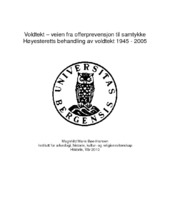Voldtekt veien fra offerprevensjon til samtykke : Høyesteretts behandling av voldtekt 1945 - 2005
Master thesis
Permanent lenke
https://hdl.handle.net/1956/4170Utgivelsesdato
2010-05-18Metadata
Vis full innførselSammendrag
I denne oppgaven studerer jeg hvordan den norske domstolen representert ved Høyesterett, har behandlet voldtekt i årene fra 1945 til 2005. Jeg har sett på hva som har stått i lovteksten i perioden, og i forarbeidet til lovene har jeg sette på hvordan lovgiverne har ønsket at voldtekt skal behandles, og ved å studere og kategorisere de voldtekts dommene som har vært i Høyesterett i årene 1945-2005 har jeg både fått innblikk i hvordan Høyesterett dømte og hvordan de begrunnet bedømmingen. The focus of this essay is to debate how The Norwegian Supreme Court has ruled in the verdicts of rape between 1945 and 2005, and particularly to see which perceptions The Supreme Court has given of the victim, the defendant and the actual rape incidence. The method I use is to highlight which aspects the Supreme Court has found to increase or decrease the seriousness of the crime. By looking at the law, and the preparatory text preceding the implementation of the law, I give an opinion of how the Norwegian Storting has meant the law to be honored. I compare this to the actual verdicts from the Supreme Court. To categorize the relevant information I have compiled three worksheets, the first representing the timeframe from 1945 to 1970, the second representing the timeframe from 1970 until 1985, and the last worksheet covers the years between 1985 until 2005. Imbedded in the worksheets are milestones for the onset and development of the women's liberation movement, and timeframes for how the critique vocalized from this movement had an influence on the verdicts of the Norwegian Supreme Court. I have compiled three hypotheses during my work. I propose that The Supreme Court has a defined understanding of what constitutes an actual rape, both in relationship to how credible the victim is perceived to be, and in relation to how and why the rape occurred. I further propose that in order for the rape to be perceived as serious there has to be involved a certain amount of violence in completion of the rape, and that sparse violence is perceived as low resistance to act of rape. I propose that the changes seen in the verdicts after 1970 can be attributed to the growing influence of the women's liberation movement.
Utgiver
The University of BergenOpphavsrett
Copyright the author. All rights reservedThe author
